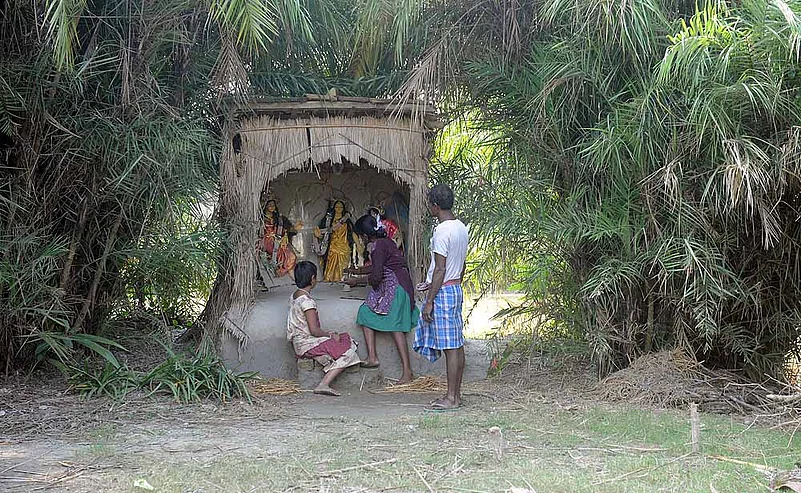Amal Gaine pulls up abruptly as we mention the words ‘Bon Bibi’. A cycle-van puller who conveys passengers back and forth on the perilous jungle pathways of the Sunderbans on what he calls his ‘car’—really just a wooden plank on the back of a cycle—he puts his palms together and touches his forehead reverentially. Then he turns back at us slowly and whispers, “Bon Bibi is the goddess who fulfils the single biggest wish in this part of the world”. He pauses for effect, then paddles on towards our ominously named destination—Tiger mode (literally, Tiger Crossing). Across the river from that point are forests with some of the world’s fiercest jungle cats. “What wish are you talking about?” we ask, as if it needed any elaboration. “To save us from incurring the wrath of the tiger king, Raja Dakshinirai,” he says without turning back.
The Sunderbans are the world’s largest delta, densely forested, watered by winding rivers, and home to the nearly amphibious and wholly lethal Royal Bengal Tiger. Its human inhabitants, who live in villages that dot the fringes of jungle, have earned their livelihood from the forest for centuries—hunting (when that was legal), fishing, collecting honey. Risk to life is a routine thing here; their forays into the jungle are always fraught affairs. The delta waters are infested with crocodiles and poisonous snakes. But it’s tiger attacks that offer a leitmotif for life. “It’s a daily threat for us here, not just when we go into the forest but also when tigers stray into the villages, which isn’t uncommon at all,” Amal says. He is right. Ever since man started living cheek-by-jowl with the nearly impenetrable mangrove thickets of the Sunderbans, thousands have lost their lives to stalking tigers.

Photograph by Sandipan Chatterjee
The tradition of Bon Bibi, experts tell us, is traced back hundreds of years. “It is not known when the first temple to the tiger goddess or the forest goddess was set up but it is likely that the goddess made her appearance as long back as we humans started intruding on the turf of the tigers,” explains 65-year-old Basudeb Barui, a fisherman, who has come face to face with the wild cat a number of times and calls it the “most terrifying experience” anyone can imagine. Barui says for anyone not to seek the blessings of Bon Bibi before setting foot in the forest is unheard of. “I don’t know a single person in my long life who has dared to go into the forest without praying to her first.” Villagers point out that not only those (mostly men) going into the jungle, but even those who stay at home (“the women—wives, mothers, sisters, daughters”) keep praying to Bon Bibi for the safety of their men. “In some households, it’s a daily ritual for the women to propitiate the jungle goddess by fasting or by other forms of worship until the men return,” Barui says.
One legend accords to Bon Bibi an Arab ancestry—the name carries this Islamic residue. By this lore, she is the daughter of a Sufi fakir, a childless man until a divine spirit appeared before him and declared that children would be born to him, but with a divine mission. He was instructed to send his children to this delta in India. Bon Bibi also had a twin brother, Shah Jongli, and together they were sent into the jungles to defeat the ferocious tiger king, Dakshinirai. In a fierce battle, Bon Bibi tamed the tiger king, but spared his life, urging him not to kill her human devotees. This curious status as a Muslim goddess notwithstanding, Bon Bibi is the first refuge for the superstitious from all religions—Hindu, Christian or tribal folk. And the Sunderbans have a way of fostering superstition. “Maybe she’s Muslim in origin, but we all pray to her,” says Phool Debi, a 70-year-old woman at Pakhiraloy village.
Going by her pre-eminence in the villages of the Sunderbans, many households have temples dedicated to Bon Bibi. Some are made of brick or stone, but mostly they are tiny clay huts with thatched roofs. The idols usually are made of clay. In Hindu households the deities often are clad in saris and adorned with ornaments (much like goddess Durga); the idols in Muslim temples usually show the goddess in more militant attire, dressed for war, her hair tightly braided and pulled back. The “wish-fulfilling” Bon Bibi also carries a young boy in her lap. As per legend, he is ‘Dukhi’, whose uncles, fearing for their lives, had sacrificed him to the tiger god, but who was subsequently saved by the merciful Bon Bibi. Dukhi represents the common villager—a symbol for the men and women who ardently believe in their goddess’s potency, knowing in their hearts that the jungle holds no terror for them as long as they secure Bon Bibi’s blessing.


























